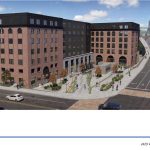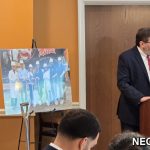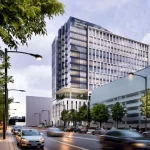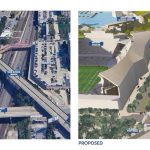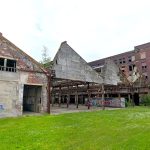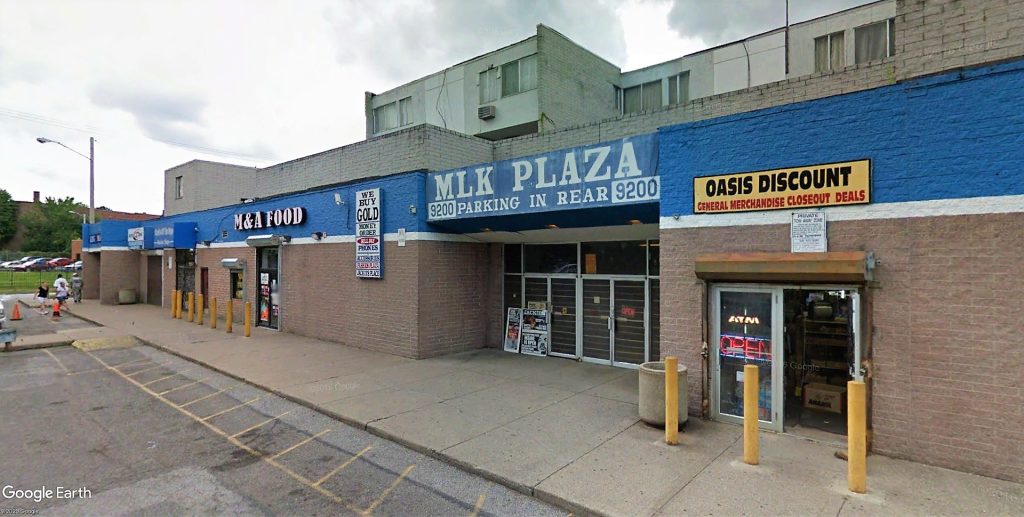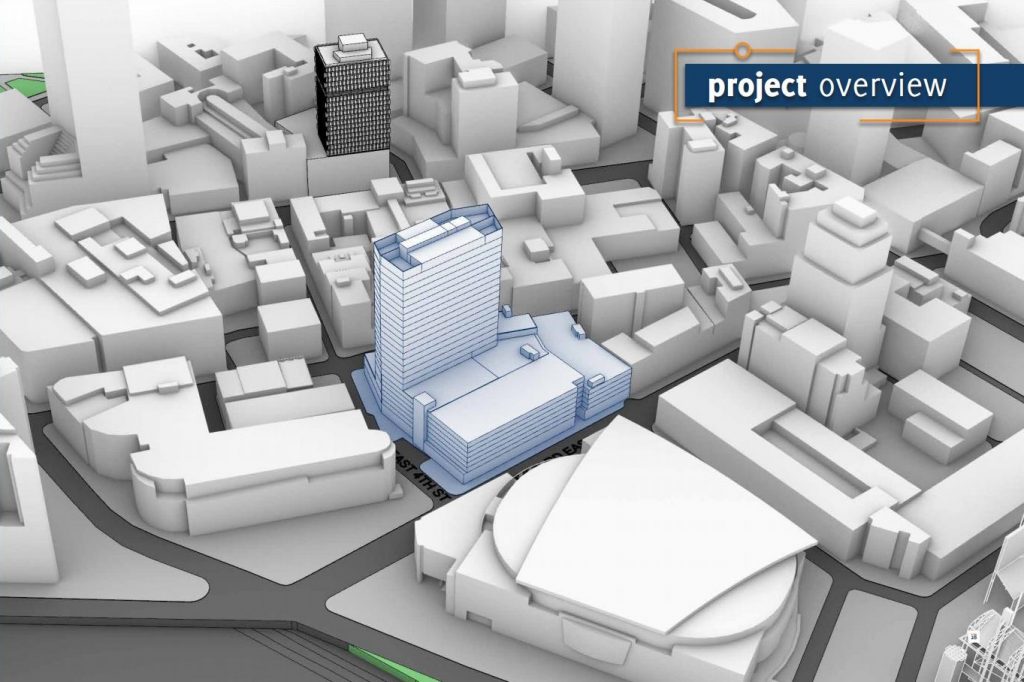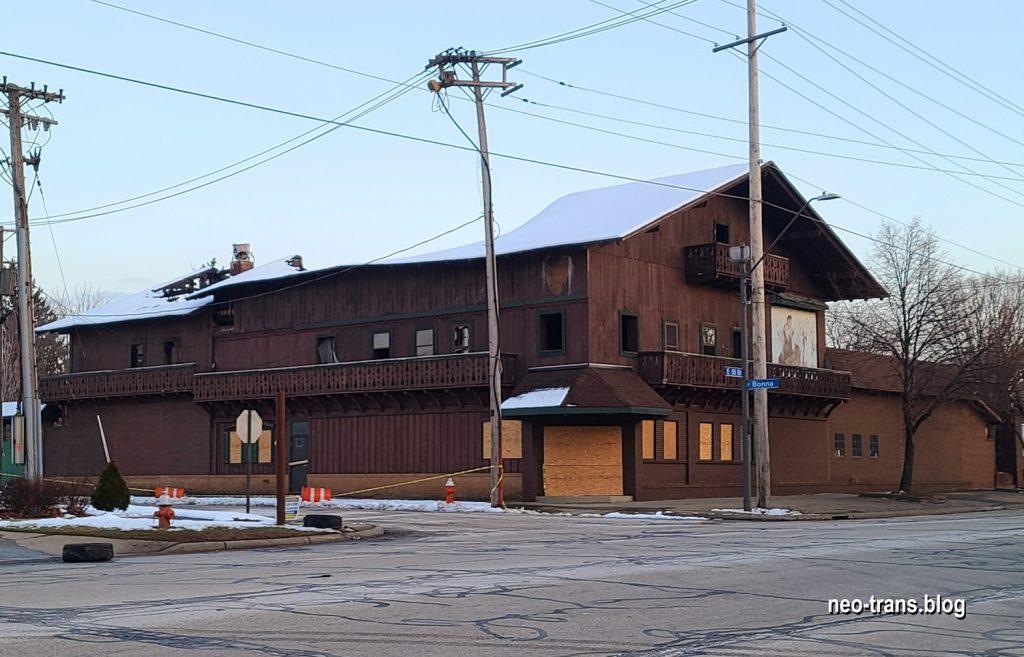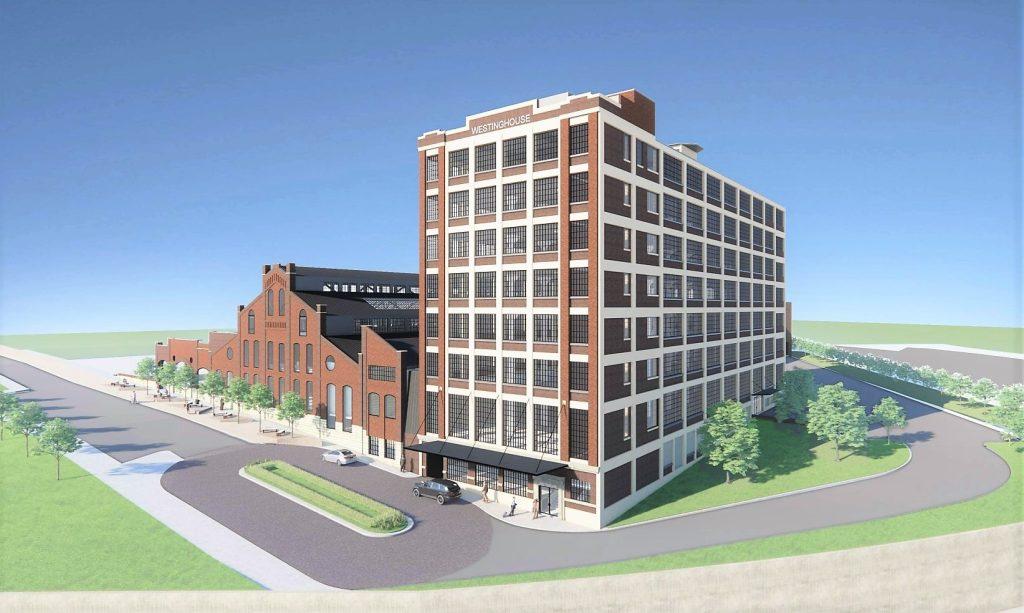
A recent rendering of the planned Westinghouse redevelopment. While this image is from a 2021 plan for the project, the proposed features in this angle showing the West 58th Street frontage at left and the lake-facing side at right haven’t substantially changed in the current planning (Trebilco/AECOM). CLICK IMAGES TO ENLARGE THEM
MCPC warehouse to be site’s largest user
Plans for the Westinghouse redevelopment got a lot clearer this week after NEOtrans was able to secure recent conceptual plans for the project. While a luxury boutique hotel and apartments are likely to be the highest-profile features in a pending redevelopment of the former Westinghouse plant overlooking the West Shoreway, a less sexy land use will be the plan’s bread and butter. That use is a planned warehouse for Cleveland-based MCPC, an information technology company that helps businesses manage security risks and logistical challenges.
While the plans for the property at 1200 W. 58th St. have been refined over time, the most significant updates are due to the importance of MCPC’s physical and financial presence in the redevelopment. MCPC executives, namely the Trebilcock family which founded the technology firm, created another company called Trebilco LLC to be the lead developer of the Westingthouse project. A third Trebilcock company, Westinghouse-Breakwater Properties LLC, bought the 3.6-acre property 13 months ago for an undisclosed amount, county records show. On that property are three principal structures — the tower, the foundry and the manufacturing building.
In 2021, Trebilco’s conceptual plans were to renovate the 281,800-square-foot factory whose roots go back to the 1880s, creating a 100,000-square-foot warehouse for MCPC’s computer hardware recycling business. The firm has been growing rapidly. In 2018, it purchased a 121,322 square-foot bus garage-turned-logistics center at 4371 Pearl Rd. in Cleveland’s Old Brooklyn neighborhood and it leases from Weston Group nearly 185,000 square feet of office and warehouse space at 21000-21500 Aerospace Pkwy. next to Hopkins International Airport.
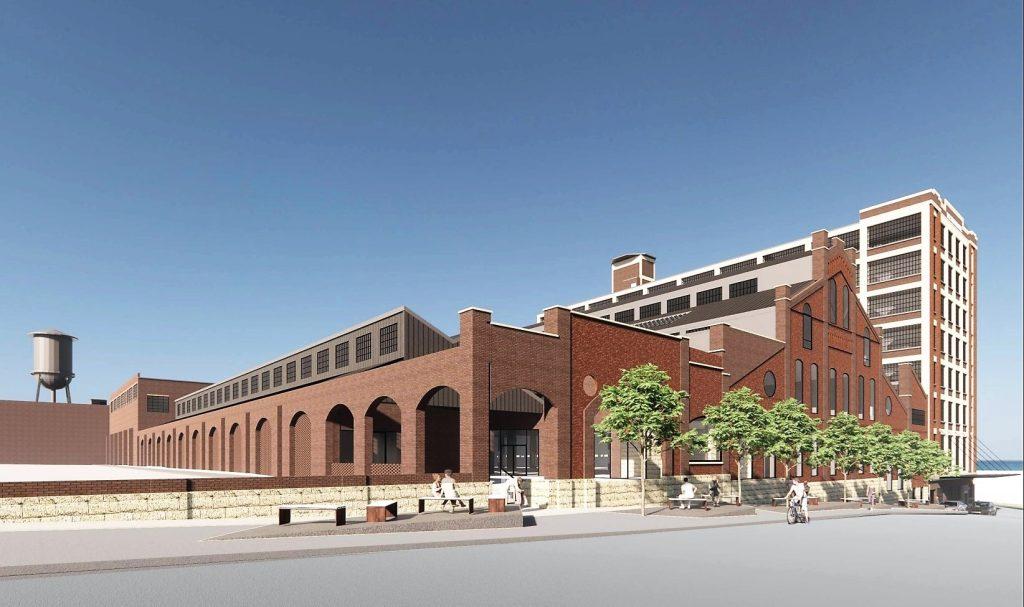
This is the southeast corner of the Westinghouse site after renovation and conversion to mixed uses. Structures along the West 58th Street frontage to the right of the left-most tree will remain as shown here but the left may be redesigned somewhat compared to what’s shown here. However the developer is seeking to retain as much of the site’s perimeter structures, including the south-facing wall and the water tower building at left (Trebilco/AECOM).
In last year’s version, the Westinghouse plans showed inserting another floor into the manufacturing building and a western portion of the foundry for the MCPC warehouse and for two-level parking garage. Parking represents the second-largest use proposed in the redevelopment. Preliminary plans show that more than 86,000 square feet of parking is desired which equates to about 250-275 parking spaces in addition to nearly 50 outdoor parking spaces for residents between the north side of the factory and the Norfolk Southern Corp. railroad tracks. A few on-street parking spaces are also planned along West 58th.
But inserting that extra floor of warehousing and parking into the aging, polluted brick structures apparently proved too difficult and costly. The 2021 plans noted that it was probable that at least some of the manufacturing building and foundry would have to be replaced. So a different approach was pursued by MCPC and its development team, including general contractor Krill Co. of Cleveland, architect AoDK Architecture of Lakewood and civil engineer AECOM, a global firm based in Dallas but with an office in Cleveland.
As previously reported exclusively by NEOtrans, the development team is now preparing to demolish one-half of the factory — namely the entire manufacturing building (minus the water tower building) and western two-thirds of the foundry for the new MCPC warehouse and parking deck. Those demolitions are primarily at the interior of the site. That will leave historic buildings or façades around the southern, eastern and northern perimeters of the former factory. That includes a factory wall along the southern façade.
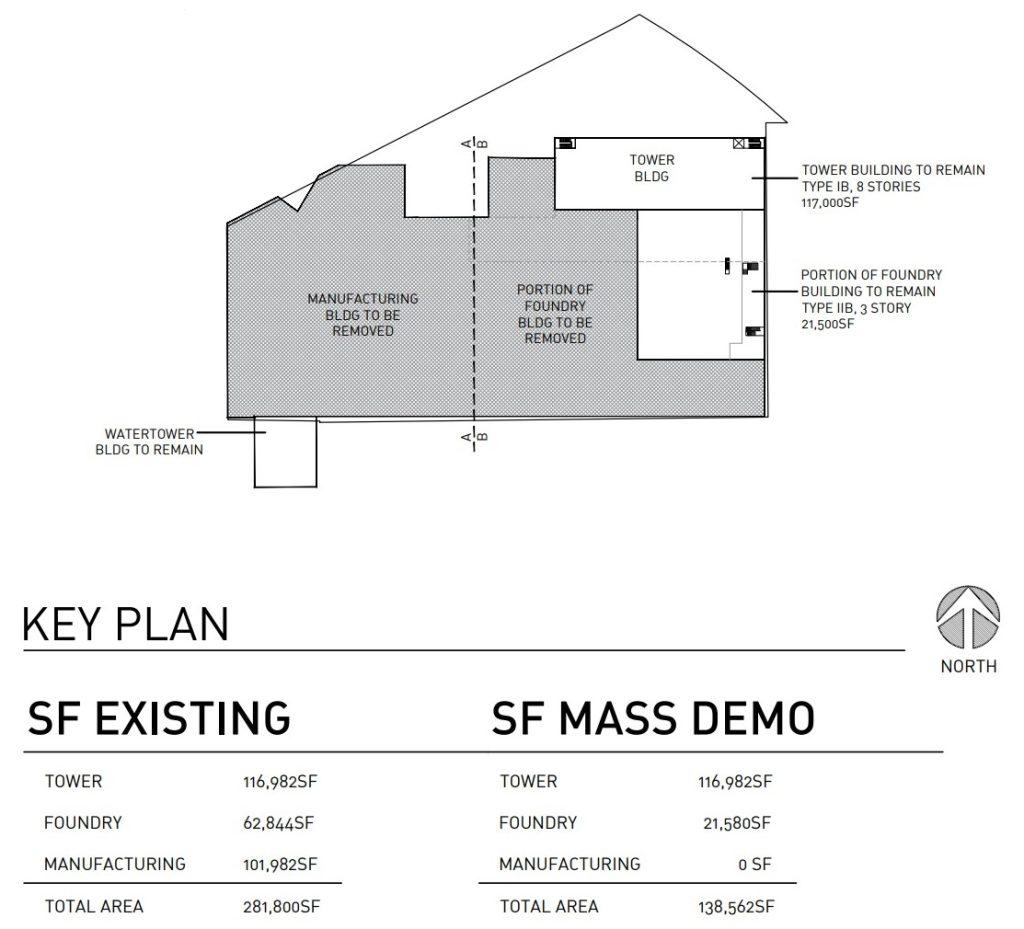
This is a summary of which structures will be demolished and which ones will be kept. The floor space in each of three basic structures is shown before demolition at left and after demolition at right. Mass demolition refers to the removal of entire structures and differs from interior demolitions in which interior walls, floors, equipment, fixtures, ducts and conduits are removed (AoDK).
The 1915-built, eight-story, 136-foot-tall tower will not be torn down. It is proposed to be thoroughly renovated and converted into 30 apartments on the top two floors and approximately 92 hotel rooms on floors two through six, according to the conceptual plans. The apartments may include 12 studios, 14 one-bedroom units and four two-bedroom suites. Sizes would range from 600-615 square feet for studios, 700-800 square feet for one-bedroom units and 750-850 square feet for two-bedroom suites. Hotel rooms are estimated at 350-600 square feet each. The tower will have unobstructed views in all directions, including of Lake Erie to the north and downtown Cleveland to the east.
The ground floor of the tower and its adjacent building will have the lobby and back-of-the-house (BOH) support facilities for the hotel. An architectural staircase, such as an ornate circular stairway, is proposed for the lobby. The boutique hotel brand hasn’t appeared in any of plans seen by NEOtrans and development team members aren’t publicly talking about them.
Michael Trebilcock Jr., manager of Trebilco, had no comment for this article. Also, an e-mail seeking comment and sent by NEOtrans to Adam Stalder, executive director at the Northwest Neighborhoods community development corporation, was opened but not responded to prior to publication of this article. The development is located in Cleveland’s Gordon Square neighborhood.
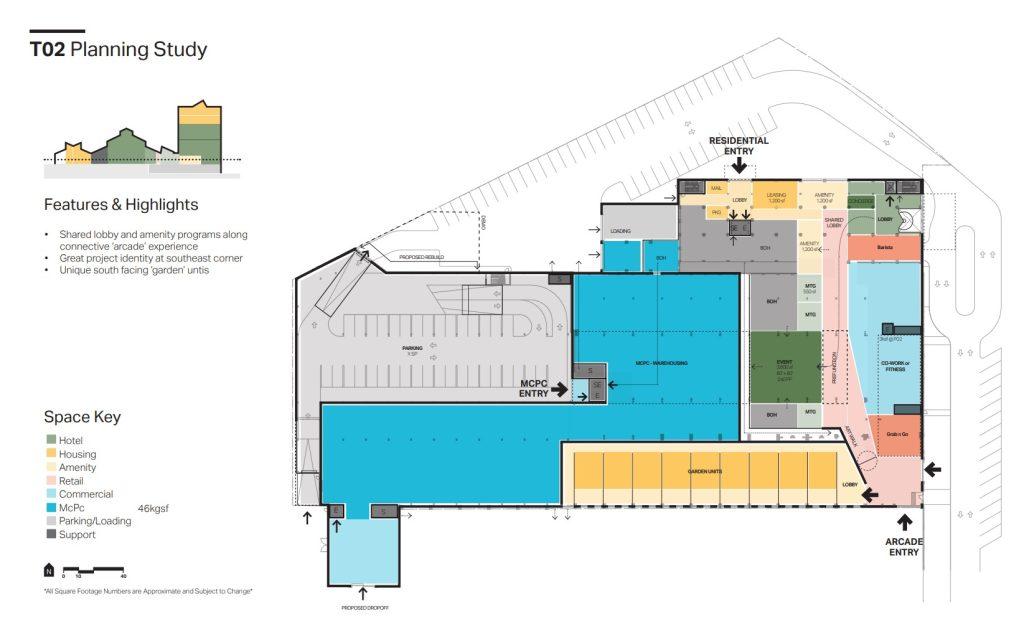
Potential ground-floor uses for the Westinghouse redevelopment are shown here. West 58th Street is to the right and the railroad tracks at the top. The pink corridor is a new arcade through the surviving portion of the foundry and into the tower’s ground floor. The arcade will be lined with mixed uses (Trebilco/AECOM).
“We’re making excellent progress but no details are public at this time,” Trebilcock said in June. “(I’m) happy to provide complete and accurate information once we are ready.”
An interesting feature of the conceptual plans, a feature which appears to still be included based on September’s demolition application, is the creation of an “arcade” in the surviving portion of the foundry which has a high-ceiling. The arcade will run north-south in what has historically been an east-west building. Along the arcade will be an art walk, event and meeting spaces, fitness center and/or co-working space, a small eatery and a barista space, plans show. The arcade would serve as “an internal ‘street’ that organizes the project’s programmatic components and creates an amenity-rich, mixed-use experience,” according to the plans.
Sources familiar with the project said a fine-dining restaurant is also in the works, possibly for the so-called “water tower building” at the southwest corner of the factory, next to The Edison at Gordon Square apartment complex that was built in 2017. The water tower building has floor plates measuring about 4,000 square feet and enough vertical space for two levels. It is shown as for use by a future commercial tenant. The water tower atop this structure is presented in the plans as a potential branding opportunity.

This aerial view shows some of the materials to be used in the Westinghouse site’s redevelopment. Since it is from last year, the diagram references that portions of the manufacturing building and foundry may require replacement, a possibility that became reality. The entire manufacturing building and two-thirds of the foundry are to be demolished, according to updated plans (Trebilco/AECOM).
The conceptual plans from 2021 also had a nine-unit row of garden apartments along the south edge of the factory. They would have used the low end of the foundry’s cantilevered roof to offer a clerestory window for a loft level added to this row and a roof trellis for a garden patio with a southern exposure. However, this row, aside from the southernmost factory wall, is proposed to be demolished to provide construction vehicle access to the newly built interior of the site from West 58th. It isn’t clear what, if anything, will be restored or otherwise built here in the final plans.
Demolition costs are estimated at $1.3 million, according to the documents that were submitted in September to the city’s Building and Housing Department. The work, already underway in the tower but limited to interior demo, is being funded by a $2.6 million grant awarded in April by the Ohio Department of Development to Westinghouse-Breakwater Properties. The work is for “The abatement of hazardous materials and demolition of hazardous sites,” according to a written statement from the state.
The Westinghouse Lighting Division ceased operations at the plant in 1979 after nearly 100 years. Westinghouse relocated its operations nearby to a much smaller building at 5901 Breakwater Ave. for just two more years. Some of the structures on the original site north of Breakwater date to 1882. At its peak, the Westinghouse plant covered 13 acres and employed more than 500 people, according to the Encyclopedia of Cleveland History. The factory was bought by the Kole family in 1986 but used for their Paramount Stamping, Welding & Wireforming Co. since 1981, county property records show. Paramount manufactured steel automobile seat frames and employed 300 people, then closed in 2019.
END

